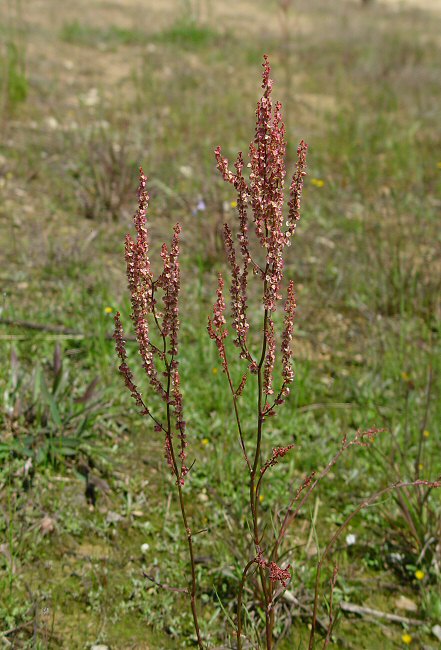Rumex hastatulus Baldwin
Wild Sorrel

Native
CC = 3
CW = 3
MOC = 6
© DETenaglia
Rumex hastatulus BaldwinWild Sorrel | |
 |
Native CC = 3 CW = 3 MOC = 6 |
© DETenaglia |
|
Family - Polygonaceae Habit - Annual or short-lived perennial forb, dioecious, rarely incompletely so, with a slender, sometimes somewhat woody, vertical rootstock, often appearing taprooted. Stems - Ascending to erect, to 40 cm, sometimes multiple from the base, usually unbranched below the inflorescence, longitudinally ridged, glabrous.
Leaves - Alternate and with a well-developed basal rosette at flowering. Ocreae membranous to papery, becoming irregularly dissected at maturity, light brown to reddish brown at the base, grading abruptly to white or pale and translucent toward the tip. Basal leaves mostly long-petiolate, the blades similar to those of the lower stem leaves. Blades of stem leaves 2-6 cm long and 0.5-2.0 cm wide, thin and herbaceous to slightly succulent, narrowly ovate to oblong-lanceolate, lanceolate, or oblong-obovate, with a pair of spreading, bluntly triangular basal lobes, occasionally unlobed, the margins otherwise entire, flat or nearly so, truncate to slightly concave at the base, angled or tapered to a bluntly or sharply pointed tip, rarely rounded at the tip, the surfaces glabrous.
Inflorescences - Terminal, usually occupying the upper 1/2-2/3 of the plant, narrowly paniculate, usually somewhat zigzag, occasionally reclining, interrupted. Flowers 3-6 per whorled fascicle, the stalks 1.5-3.0 mm, about as long as to slightly longer than the fruiting perianth, arched downward or nodding at maturity, jointed below the midpoint.
Flowers - Pistillate flowers with the inner whorl of tepals becoming enlarged to 2.5-3.2 mm long and 2.7-3.2 mm wide at fruiting, winged, broadly ovate to nearly circular, broadly cordate to rounded at the base, bluntly to more or less sharply pointed at the tip, the margins entire, the surfaces with a network of prominent nerves; tubercles absent or the midnerves slightly swollen toward the base; outer whorl of tepals reflexed at fruiting.
Fruits - Fruits 0.9-1.2 mm long, 0.6-0.8 mm wide, brown to dark brown.
Flowering - April - June. Habitat - Glades, upland prairies, also pastures, railroads, and sandy, open ground. Origin - Native to the U.S. Lookalikes - R. acetosella. Other info. - This species is uncommon in Missouri, found in a few scattered counties in the Bootheel. The plant is much less common than the similar R. acetosella, which is an introduced species from Europe. It is much more common to our south and southeast, and in some areas there can be seen along nearly every roadway. The plant is recognized by its hastate leaves, greatly expanded and prominently nerved fruit wings, and pedicels which are jointed near the middle rather than just beneath the tepals. Differentiation from R. acetosella can be very difficult for plants not in fruit. Photographs taken in Kissimmee, FL., 2-12-03 and in Vale, NC., 5-11-03 (DETenaglia); also at Sand Prairie Conservation Area, Scott County, MO, 5-6-2020 (SRTurner). |